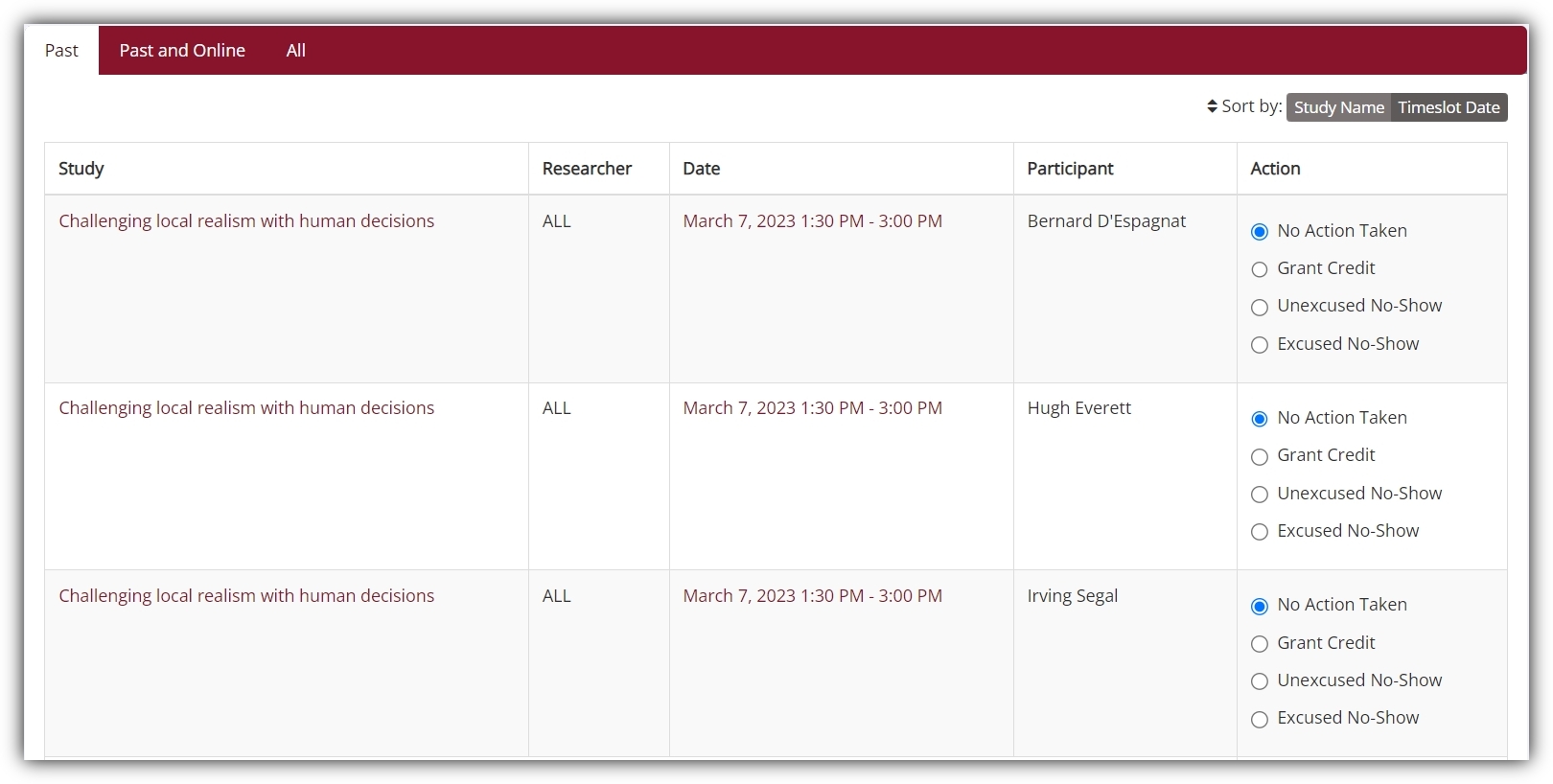
Uncredited Timeslots: Back to the Feature “Past”
Published March 17, 2023
Making Research Happen: The Role of Uncredited Timeslots
The Sona platform is much more than simply a recruitment tool or an online credit granting system. Sure, Sona does both of these things. But it also organizes research and the scientists, participants, and institutions conducting it. In play even before the recruitment process begins and an essential tool after studies are finished, Sona provides comprehensive research structure and optimizes the research process. One primary method employed in this capacity is, of course, ensuring that researchers have data. This in turn means not just recruiting participants but also ensuring they know what they will be doing, where they are doing it, and when they should be there.
All this may sound research-focused, and it is. But it is not where Sona’s role ends, nor is the Sona platform so “researcher-centric”. Science driven by Sona doesn’t use satellites or particle accelerators. It relies on people, who volunteer their time as part of a mutually beneficial interaction that the Sona platform facilitates. This is, perhaps, better realized in no aspect of any Sona site than the Uncredited Timeslots page.
Whereas timeslots themselves are perhaps more central to the research process, the Uncredited Timeslots page is about making sure that participants who’ve fulfilled their obligations aren’t missed because e.g., a research assistant accidently skipped over an ID on a list while granting credit or marking no-shows after debrief. Of course, the Uncredited Timeslots page also helps maximize research productivity by restricting repeated no-shows to research alternatives.
Mainly, though, this page is the other side of the coin. The calendar, the timeslots themselves, the participant reminders, the study postings, and so much more are all about making sure interested participants show up where and when they have agreed to volunteer their time. The page with Uncredited Timeslots tab views is all about making sure researchers fulfill their obligations to participants, and helping them do so both in a timely fashion and as easily as is possible.
The Triple Tab Uncredited Timeslot View
This brings us right to why, after many years, we’re reintroducing the “past” tab (shown below) to the Uncredited timeslots page:

This is now the default view for Uncredited Timeslots. It shows researchers all timeslots for their standard (in-person or “lab” studies) that have passed but still have participants awaiting action.
It’s also an interesting quirk of history. The function itself is not new, yet because of the new context, it’s still a new feature. Before we continue, it might be useful to reassure everyone that we’re not removing any tabs or other features you’ve enjoyed here. We’re simply making things more efficient to accommodate different research groups (or the same researchers over time) with different needs. Providing some of this context will help explain how.
Days of Features Past: Timeslot Tabs Come and Gone
Researchers have used the Sona platform for online studies before online survey platforms were widely used, let alone capable of integration support. Before we introduced automatic credit granting and participation marking, researchers still handled this process in a manner similar to the way scheduled timeslots were and are. They would log in and grant credit for participation. To make this easier, we added a tab to the Uncredited Timeslots view that you can still see: “Past and Online”. Researchers who ran online studies could use this tab to keep track of participants who might, at any time, complete one of their active online studies. But there were still so many in-person studies relative to online that we kept the “Past” tab view.
This changed, and in more ways than one. First, online studies are common across a growing number of fields. The “Past and Online” tab is a convenient one-stop location that lists all scheduled timeslots now in the past as well as online sign-ups that may require attention. This might have led to a new “Online” tab showing only uncredited online sign-ups, were it not for the second change.
The second, and bigger change, was all about that qualifier “may” in “may require attention”. We introduced automatic participation marking and credit granting support for all the most popular (and many less widely used) online survey tools and platforms. This meant that participants who start and finish online studies shortly after signing up either never made it onto any Uncredited Timeslots table in the “Past and Online” tab view, or were taken off quickly once they completed the study.
In short, it meant that there were far, far fewer participants in online studies who would require action. It meant that the “Past” tab was largely extraneous, and we removed it. Since then, online studies have continued to increase (as have in-person), Sona is continually making sure we offer integration support for all the online survey platforms we can (we recently added Jisc Online Surveys to the list), and we are still committed to optimizing the research process for participants and researchers alike.
New Times, New Tabs: Repurposing the Triple Tab
Why, then, are we (re)introducing the new “Past” tab feature? Put simply, we’re somewhat victims of our own successes (and of yours!). Many Sona sites run so many in-person as well as online studies that the new “Past” tab view may function the same as the old one, but together with the other two tab views it allows for different functionality.
Let’s break this new triple tab feature down a bit. Suppose researchers on your site run both online and standard, in-person studies. And let’s also suppose that your institution has a license for one, particular online survey system that everyone uses it. Chances are, this means Sona offers integration support for this survey platform, so let’s further suppose researchers on your site take advantage of this. In short, we’re supposing that all online studies are configured for automatic credit granting. What does this mean for the triple tabs in Uncredited Timeslots and the new, default “Past” view? Well, even if most of the studies on your site are online, with maybe 30-40% in-person, most of the timeslots that will appear on the “Past and Online” tab on the Uncredited Timeslots page will be for standard “lab”/in-person studies.
Perhaps more importantly, even when a researcher clicks on the “Past and Online” tab and sees that a decent number of the “timeslots” are uncredited sign-ups for online studies, in all probability no action will be needed. Usually, online, uncredited “timeslots” will be participants who have yet to click on the survey link, preferring to wait until they know they will be able to complete it without distractions. Waiting for an optimal time is a good thing, and it also means that when these participants do complete the online study they will be removed from the Uncredited Timeslots page altogether.
By contrast, any participant who signed up for a scheduled timeslot that has now past will require attention, whether to grant credit or be marked as a no-show. In such cases, researchers may very well prefer (at least most of the time) to focus on the “Past” tab view, expecting that any online sign-ups from the “Past and Online” tab will be sorted out shortly and automatically by the system. This is partly the reason for the triple tab option and the new, default “Past” tab view in Uncredited Timeslots.
Another reason is not about what researchers want to do, but rather what they don’t. Namely, they will wish to avoid accidently changing a participant’s status on the “Past and Online” tab in Uncredited Timeslots because they were distracted by (or focused on) scheduled, uncredited timeslots in the past. For example, a researcher might be marking no-shows and notice that a participant has failed to complete the survey they signed up to take, and simply mark the participant as a no-show. It can be an easy mistake to make, but with the new “Past” tab default it is even easier to avoid.
Preventing this kind of error, and making it easier to focus attention on scheduled timeslots, is why we have introduced the new “Past” tab in Uncredited Timeslots, as well as why it is the default view. That’s where most of the attention will be required, most of the time. The rest of the time? That’s where triple tab functionality comes into play.
Making the Most of the Middle Tab for Online Studies
We already saw how to utilize the default “Past” view when you can expect most online studies to use automatic credit granting. Now suppose that one or more researchers on your Sona site regularly uses a customized survey software tool that is unique to their particular work. Although we do offer help setting up integration in such cases, and there are some instructions online to help set up integration for advanced users, for the sake of this example let’s suppose that hasn’t happened. Instead, your researchers are using this customized survey software that their participants can access online, but which isn’t set up for automatic credit granting.
Suddenly, the “Past and Online” tab in Uncredited Timeslots becomes more important, at least for these online studies. It’s now a great tool researchers can access directly from their main page after log in to check on any online studies that aren’t set up for integration,. And, as before, it’s still a one-stop place they can use to take care of any past timeslots for current, in-person studies as well.
So far, we’ve gone over two very different scenarios, but in reality things aren’t so binary. Even if, as is often the case, your researchers use supported online software and DO have their studies set up for automatic credit granting, the “Past and Online” tab view definitely has its place. Researchers can click to this view when towards the end of an online study, for example. They can also use the combined “Past and Online” tab to quickly check for signs of trouble with online studies. For example, a step skipped in the integration process can result in participants completing the study without being awarded credit. In this case, a glance at the “Past and Online” timeslots tab would reveal irregularities indicating this or similar problems.
The Past Defaults: Closing Words on Timeslots to Come
Usually, however, automatic participation marking/credit granting takes care of most online sign-ups, making the current default tab, “Past” uncredited timeslots, the most important. More often than not, the problem with uncredited “timeslots” for online studies is taking action when none is actually needed. And that, in a nutshell, is a key reason for the new(ish) “Past” tab and its status as the default view. It lets Sona handle the workload more efficiently, but allows researchers the flexibility when needed
With all that in mind, we hope this helps you make the most out of the new “Past” feature in the future, using the other tabs as timeslots demand!
Related Posts
January 2, 2024
There are many good reasons to have multiple Sona sites. […]


